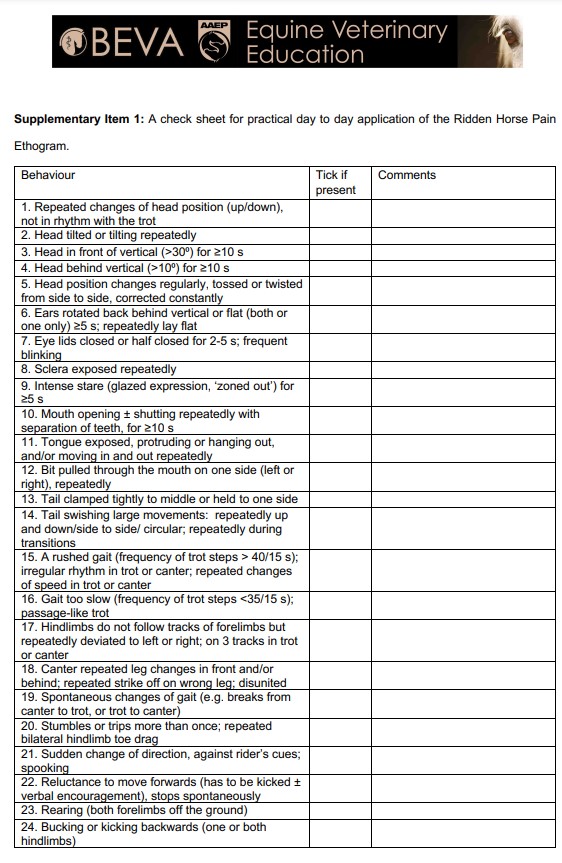One of the biggest questions horse owners have when things aren’t going right is whether its a pain induced response or a behavior. Many times Veterinarians are called out to examine the horse and if an obvious reason isn’t found then the horse is considered to have learned a bad behavior. Other times the behavior is brushed off and its said that is just how that horse is, when in reality that horse is trying to tell you that they are in pain.
In an effort to help detect lameness sooner Sue Dyson, VetMB, PhD, created the Ridden Horse Pain Ethogram (RHpE) in 2018 to help anybody detect lameness in a horse by just observing their behavior.
The RHpE is a set of 24 easily identifiable equine behaviors. If you observe 8 or more of these behaviors there is a good chance your horse has pain somewhere.

The 24 behaviors are:
1. Repeated changes of head position (up/down), not in rhythm with the trot
2. Head tilted or tilting repeatedly
3. Head “in front of vertical” (more than 30 degrees) for 10 seconds or more
4. Head “behind vertical” (more than 10 degrees) for 10 seconds or more
5. Head position changes regularly, tossed or twisted from side to side, corrected constantly
6. Ears rotated back behind vertical or flat (both or one only) five seconds or more; repeatedly lay flat
7. Eyelids closed or half-closed for two to five seconds; frequent blinking
8. Sclera (white of the eye) exposed repeatedly
9. Intense stare (glazed expression, “zoned out”) for five seconds or more
10. Mouth opening and/or shutting repeatedly with separation of teeth, for 10 seconds or more
11. Tongue exposed, protruding or hanging out, and/or moving in and out repeatedly
12. Bit pulled through the mouth on one side (left or right) repeatedly
13. Tail clamped tightly to middle or held to one side
14. Tail swishing in large movements: repeatedly up and down/side to side/circular; repeatedly during transitions
15. A rushed gait (frequency of trot steps great than 40 per 15 seconds); irregular rhythm in trot or canter; repeated changes of speed in trot or canter
16. Gait too slow (frequency of trot steps less than 35 per 15 seconds); passage‐like trot
17. Hind limbs do not follow tracks of forelimbs but repeatedly deviate to left or right; on three tracks in trot or canter
18. Repeated lead changes at the canter in front and/or behind; repeated strike off on wrong lead; disunited
19. Spontaneous changes of gait (e.g., breaks from canter to trot, or trot to canter)
20. Stumbles or trips more than once; repeated bilateral hind-limb toe drag
21. Sudden change of direction, against rider’s direction; spooking
22. Reluctance to move forward (has to be kicked and/or given verbal encouragement); stops spontaneously
23. Rearing (both forelimbs off the ground)
24. Bucking or kicking backwards (one or both hind limbs
It is always advisable to get a Veterinarian to examine your horse for any unexplained behavior even if your horse doesn’t necessarily display 8 ore more of the listed behaviors.
To read the full article click here: https://beva.onlinelibrary.wiley.com/doi/10.1111/eve.13468#:~:text=The%20Ridden%20Horse%20Pain%20Ethogram%20(RHpE)%20comprises%2024%20behaviours%2C,score%20%3C8%2F24%20behaviours.
